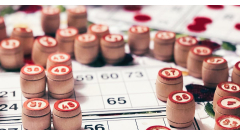Welcome to a world where learning multiplication transforms into an exhilarating game! Multiplication Bingo is not just a classroom activity; it's a resource that makes math engaging and enjoyable for students of all ages. Whether you’re a teacher looking to energize your lesson plans or a parent wanting to make homework time a breeze, this game provides a fun and interactive way to reinforce essential multiplication skills.
Imagine the excitement in the room as kids shout 'Bingo!' while mastering their times tables! With multiple ways to play, this game is designed for both small group learning and larger class settings, accommodating anywhere from 2 to 36 players. Get ready to see smiles, laughter, and a genuine love for learning blossom with each round of Multiplication Bingo!
Trend Enterprises' Multiplication Bingo is a delightful educational game designed to make math fun for everyone involved. With 8 different ways to play, it caters to a wide range of learning styles and group sizes, perfect for classrooms or home environments. Suitable for ages 8 and up, the game encourages players to sharpen their multiplication skills while fostering collaboration and competition in a lively atmosphere. Whether it's a small group or a full classroom of 36 players, Multiplication Bingo transforms the mundane into a memorable learning experience.
Game Setup
Setting up the Trend Enterprises: Multiplication Bingo Game requires careful preparation to ensure a smooth and enjoyable experience for all players. Start by distributing the Bingo cards to each player. Each card should feature a unique arrangement of multiplication problems, from the basic tables to more complex ones, appropriate for players aged 8 and up. Consider organizing the players into groups based on their skill levels, which helps create a balanced and engaging environment for everyone. It's important to provide each participant with markers or chips, which will be used to mark their answers as the multiplication problems are called out.
Next, gather all necessary materials in a central location to make gameplay seamless. This includes the calling cards that contain the answers to the multiplication problems, which can be drawn randomly. Organizing these cards either in a box or a bag makes them easily accessible as you call out the numbers. Ensure that the surroundings are conducive to learning; this can be achieved by setting up a clear, distraction-free space where players can concentrate. A well-lit area with enough space to accommodate all players will enhance focus and enjoyment.
- Have extra materials ready for larger groups, such as additional Bingo cards and markers.
- Encourage players to ask questions about the multiplication problems to facilitate a collaborative learning atmosphere.
Understanding Rules
Playing Multiplication Bingo with the Trend Enterprises Multiplication Bingo Game is an exciting way to reinforce math skills while having fun. This game allows 2 to 36 players, making it perfect for various group sizes in classrooms or at home. To start, each player receives a Bingo card filled with products of multiplication problems, which are organized in a grid format. Instead of numbers, the squares contain the answers to multiplication problems, creating an interactive and educational experience.
The game begins with one player acting as the caller. The caller randomly selects a multiplication problem, such as "6 times 4," and then announces both the problem and the answer, which is "24." Players then look for the answer on their cards. If they find it, they can mark it with a token or pen. Players should keep listening, as the caller will keep presenting new problems. Winning occurs when a player marks a complete row, column, or diagonal, and calls out "Bingo!" to claim their victory. To enhance engagement, you can incorporate various winning patterns such as forming a letter "X," a full card, or any other shape agreed upon before the game starts.
- Each Bingo card features a unique arrangement of answers.
- The caller should ensure that the problems are at varied difficulty levels.
- Players can have a limited time to mark their answers to maintain a lively pace.
Playing Variants
The Trend Enterprises Multiplication Bingo Game offers versatility through eight engaging variants designed to enhance learning and enjoyment. Each variant provides a different twist, encouraging players to sharpen their multiplication skills while keeping the game fresh and interactive.
- Classic Bingo: Players mark their cards with the products of the multiplication equations called out by the host. The goal remains to achieve a straight line, either horizontally, vertically, or diagonally. This variant emphasizes speed and accuracy in recalling multiplication facts.
- Blackout Bingo: A more challenging alternative, where players try to cover all the spaces on their card. This variant lasts longer and may require more intense concentration as each number called brings players one step closer to victory. It’s excellent for reinforcing multiplication facts over extended play.
- Speed Bingo: In this fast-paced variant, each player has only one minute to mark their cards as the host quickly calls out multiplication problems. Quick thinking and immediate responses are crucial, making this method a lively option that fosters instant recall of multiplication facts.
- Team Bingo: In this collaborative variant, players team up in groups and share knowledge. Teams work together to determine answers and mark their cards, promoting communication and teamwork. It’s a unique approach that encourages a supportive learning environment.
- Flashcard Bingo: This variant incorporates flashcards, where players must create their bingo card from multiplication problems read aloud. The choice of equations allows for targeted practice, making it beneficial for those who may need reinforcement of specific multiplication tables.
- Picture Bingo: Instead of numbers, this variant uses visual icons that represent multiplication outcomes. Players relate the images to their corresponding products, which helps younger players or visual learners connect with multiplication in a more engaging way.
- Reverse Bingo: In this twist, the host calls out answers instead of multiplication problems, and players must find the equations that yield those answers. This encourages players to think critically and engage in more complex problem-solving related to multiplication.
- Timed Challenge Bingo: Players compete against a timer to complete as much of their cards as possible within a set time limit. This variant adds an element of urgency, pushing players to work quickly and efficiently, while encouraging a kind of excitement in the classroom.
Expanding on the gameplay experience, each of these variants can be adapted or combined for even more fun! Teachers and parents can modify the rules to suit different age groups and learning levels. The Trend Enterprises Multiplication Bingo Game is designed for 2 to 36 players, making it ideal for both small group settings and larger classroom activities.
- Mix and match variants to keep sessions engaging.
- Incorporate prizes for winners to increase competitiveness.
- Use the game to fill time in educational settings with different group sizes.
Engagement Tips
To maintain high levels of participation during the Trend Enterprises: Multiplication Bingo Game, incorporating a range of engaging strategies can significantly enhance the experience for players aged 8 and up. Begin by varying your tone of voice when calling out multiplication problems. For instance, use excitement and enthusiasm to highlight important questions, creating an air of anticipation. This technique not only keeps players alert but also adds an element of drama to the game, transforming a simple educational activity into a lively event.
Encourage friendly competition by setting up mini-challenges within the game. For example, you can reward players who complete a line or achieve bingo first with small prizes or privileges, which fosters a sense of urgency and excitement. You can also incorporate team-based gameplay; form small groups to tackle questions together, promoting collaboration and allowing participants to learn from one another. Mixing up the gameplay styles—such as alternating between individual and team-based turns—can also keep everyone engaged throughout the session.
- Implement periodic shout-outs for great teamwork or clever strategies.
- Utilize visual aids like colorful Bingo cards that keep the atmosphere vibrant.
- Offer a "bonus round" with tougher problems to challenge more advanced players.
Incorporating Learning
Playing Multiplication Bingo with Trend Enterprises' game is an engaging way to reinforce math skills while making learning enjoyable. This game isn't just about calling out numbers; it can be skillfully woven into broader educational curricula. For instance, educators can introduce a session on multiplication and its applications in real life—such as budgeting, cooking, or even sports statistics—before starting the game. Students can create word problems based on their bingo cards or explain how multiplication is useful in various scenarios, effectively connecting classroom activities with practical use. This approach encourages students to think critically about how they apply what they learn.
Additionally, Multiplication Bingo serves as a vibrant backdrop for teaching essential social skills. As players collaborate and share bingo cards or assist each other in checking for matches, they're not just practicing math; they're learning the importance of teamwork and communication. The nature of the game allows for various playful formats, prompting students to strategize as they compete for a win. This not only enhances their mathematical understanding but also cultivates skills such as patience, respect for others, and sportsmanship.
- Engage students by linking the game to everyday situations involving multiplication.
- Encourage collaborative problem-solving while playing, fostering teamwork.
- Use the game to introduce concepts of probability or statistics in math lessons.
- Incorporate storytelling where students create multiplication-based stories based on their bingo outcomes.
Adapting for Different Ages
When using the Trend Enterprises Multiplication Bingo Game, educators can easily modify the game to cater to various age groups and skill levels. For younger players or those just beginning to learn multiplication, the introduction of simpler multiplication problems is essential. Instead of focusing on challenging combinations, such as 7x8 or 9x6, the game can primarily feature single-digit multipliers and products. This allows learners to become comfortable with basic multiplication facts, enabling a smoother progression in their understanding of the multiplication concept. Consider using problems like 2x3 or 4x5, as these are more accessible and can help build confidence in younger learners.
As students grow in age and skill level, the complexity can be gradually increased to ensure that the game remains engaging and challenging. For older players or those who have mastered basic multiplication, incorporate two-digit multiplication problems or even include division questions to enrich the gameplay experience. Additionally, you can consider varying the bingo board layout, using larger grids (like 4x4 or 5x5) for advanced players. This adjustment not only enhances cognitive skills but also encourages strategic thinking as players need to mark multiple answers and create winning patterns in a more extensive setup.
- For younger players: Use single-digit multiplication (e.g., 1-9).
- Introduce addition or simple grouping on bingo cards for a less challenging start.
- For advanced learners: Add two-digit multiplication scenarios or mixed operations.
- Utilize bingo board sizes of 4x4 or larger to extend gameplay.
- Create themed bingo cards to keep the game fresh and exciting at all age levels.
Problem Creation
Creating multiplication problems for the Trend Enterprises: Multiplication Bingo Game adds an engaging twist to a classic classroom activity, making learning fun. Begin by determining the multiplication range suitable for your players, typically involving numbers 1 through 12, as these are commonly taught in elementary classrooms. Start by crafting a balanced mix of multiplication problems that can challenge students while still catering to varying skill levels. This ensures that all players feel included and engaged throughout the game.
For instance, you might create a few straightforward problems like 2 x 3 and 4 x 5, ensuring beginners have accessible options. Gradually introduce more challenging problems, such as 7 x 9 or 8 x 12, to cater to confident learners. Aim for a bingo board filled with a mix of these difficulties, ensuring that each player's board has at least one very easy problem, a few medium, and a couple of tough ones. This approach not only helps in keeping the game balanced but also enhances the learning experience for everyone involved.
- Consider using an assortment of problems that require different strategies to solve, prompting players to think critically.
- Use colors or symbols to indicate easier or more challenging problems, which can help players to mentally prepare and strategize their approach.
Promoting Friendly Competition
Creating a competitive yet friendly atmosphere while playing the Trend Enterprises Multiplication Bingo can significantly enhance the learning experience. To kick off a healthy competitive spirit, begin by setting clear goals for the players. You might organize the game into multiple rounds, where each round can have a different multiplication theme or focus, such as 'factors of ten' in one round and 'double digits' in another. This adds variety and keeps players engaged, while also maintaining the educational aspect of the game. Players can be encouraged to cheer for their classmates when they achieve a Bingo or complete a difficult problem, fostering camaraderie among them.
Introducing tournaments can further amp up the excitement. You could create brackets where different teams or individuals can compete against each other in successive rounds. For instance, maintaining a leaderboard where students earn points for each Bingo they achieve or for correct answers can motivate them to perform their best. Rotating team assignments or allowing players to form their own teams can lead to collaboration and strategy discussions, which are essential for deeper understanding and retention of multiplication concepts. Here are some ideas to weave competition into your Bingo game:
- Hold elimination rounds to determine finalists for a grand tournament.
- Offer small rewards for the most enthusiastic participants, such as stickers or homework passes.
- Encourage players to create their Bingo boards with unique multiplications, enhancing creativity and personal investment.
Feedback and Reflection
After playing Trend Enterprises’ Multiplication Bingo Game, it is incredibly valuable for players to engage in feedback and reflection. This activity allows participants to assess their understanding of multiplication while fostering a supportive learning environment. Encourage players to share their experiences, discussing not only the strategies they used during the game but also how the activity impacted their understanding of the multiplication concepts. This discussion can deepen learning and help everyone appreciate different approaches to problem-solving.
To prompt meaningful reflections, consider asking the following questions:
- What new multiplication strategies did you discover while playing?
- Which bingo patterns did you find most effective, and why?
- How confident did you feel in solving the multiplication problems presented during the game?
- Were there any moments in the game that surprised you or challenged your understanding?
- How can you apply what you learned from this game to future math challenges?
Providing some time for discussion after the game allows participants to verbalize their thoughts and feelings, enhancing their learning experience. Reflection on performance and strategy can also promote collaboration among players, encouraging them to support one another in mastering multiplication.
- What skills do you think you improved on as a result of this activity?
- How did teamwork play a role in your experience during the game?
Facilitating Group Dynamics
Engaging students in the Trend Enterprises Multiplication Bingo Game can foster teamwork while amplifying excitement and learning. To manage group dynamics effectively during gameplay, it's crucial to observe interactions among players and proactively promote an inclusive environment. Begin by arranging the players in groups of equal size, allowing for more manageable dynamics. Assign roles within each group to encourage participation, such as a team leader who can call out numbers or a scribe who keeps track of marked cards. This engagement not only keeps everyone involved but also nurtures a sense of responsibility and belonging.
During gameplay, be vigilant for signs of conflict, such as disagreements over rules or competitive tension. If conflicts arise, addressing them quickly and fairly is key. Encourage open communication, allowing students to voice their concerns or frustrations. Facilitate a brief discussion if needed, allowing players to express their feelings while guiding them towards resolution. Remind them of the cooperative nature of the game and reiterate its purpose: learning multiplication in a fun way. To further enhance group dynamics, consider these methods:
- Rotate roles within groups for each round to provide varying responsibilities and perspectives.
- Use icebreakers or team-building exercises during breaks to strengthen relationships among players.
- Encourage positive reinforcement; players can commend one another for correct answers or good play.
Why We Chose This Product
Choosing to create this guide on how to play Multiplication Bingo stems from a belief that learning should never feel tedious or overwhelming. By offering a game that blends education with enjoyment, students can grasp multiplication concepts more effectively. This product allows for adaptable gameplay, which is ideal for diverse learning environments—whether at home or in the classroom.
- Engages students through interactive play
- Encourages teamwork and social interaction
- Strengthens math skills in a fun context
- Offers various playing styles to suit different preferences
Every educator or parent knows the importance of making learning enjoyable, and Multiplication Bingo accomplishes this beautifully. By providing a way for kids to learn while laughing and cheering, this game becomes more than just a tool; it becomes a cherished memory in their educational journey.
Trend Enterprises' Multiplication Bingo is a delightful educational game designed to make math fun for everyone involved. With 8 different ways to play, it caters to a wide range of learning styles and group sizes, perfect for classrooms or home environments. Suitable for ages 8 and up, the game encourages players to sharpen their multiplication skills while fostering collaboration and competition in a lively atmosphere. Whether it's a small group or a full classroom of 36 players, Multiplication Bingo transforms the mundane into a memorable learning experience.










